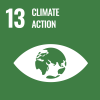Nigeria – Across Nigeria, serene landscapes have been transformed into vast expanses of water. While the country is no stranger to heavy rainfall which often causes rivers to swell, this year’s floods have left a trail of destruction that has affected millions. Homes, schools, and farmlands have been submerged, leaving communities grappling with the aftermath of nature's fury.
A trail of destruction
Out of Nigeria’s 36 states, 31 have been affected by the floods which have caused more than 300 casualties and displaced 673,000 persons. Across the country, essential services have been disrupted as critical infrastructures including roads, markets, bridges connecting communities, schools and houses were destroyed by the waters.
Additionally, the floods are estimated to have destroyed 850,000 tons of crops, or enough food to feed 8.5 million people for six months, according to the Food and Agriculture Organization (FAO).

IOM provides non-food items and hygiene kits to displaced population upon arrival in the temporary camp. Baba is one of the new arrivals to Bakassi Camp. Photo: IOM 2024/Elijah Elaigwu
“A crisis within a crisis”
In Borno, Adamawa and Yobe States, which have been the hardest hit, the flooding has created “a crisis within a crisis”, as dozens of locations hosting displaced persons were overtaken by the waters, forcing internally displaced persons (IDPs) into secondary, and sometimes more complex displacement patterns.
In Borno State, public and private schools were temporarily closed for two weeks in mid-September as the State grappled with the impact of the consequences of the floods.

Women and children are among the most vulnerable populations affected by the floods. In the camp, IOM provides psychosocial support to help them cope with the traumatic experience of displacement. Photo: IOM 2024/Elijah Elaigwu
Besides heightened food security, the floods have elevated public health risks with the outbreak and spread of cholera in communities.
Rebuilding lives
As the waters recede in some parts of the country, the daunting task of rebuilding begins. As families work tirelessly to salvage their belongings, their determination is undeterred by the magnitude of the task ahead.

At Gubio camp, IOM Camp Coordination and Camp Management (CCCM) is actively engaged in collecting data and analyzing information on household sizes, demographics, and vulnerabilities to ensure accurate information on the number of households for better resource allocation. Photo: IOM 2024/Elijah Elaigwu
From the day the flooding began, IOM has worked closely with Federal and State agencies in providing technical support and lifesaving assistance to those most affected. IOM swiftly deployed the Displacement Tracking Matrix (DTM) to support local authorities and humanitarian actors including the Nigeria Red Cross with data collection in deep locations affected by the floods.
This data is critical to inform humanitarian responses and policy development.

The IOM DTM team continues to support the government through comprehensive data collection and registration of new arrivals in camp. Photo: IOM 2024/Elijah Elaigwu
Through Camp Coordination and Camp Management (CCCM), IOM helps local actors coordinate and manage the overall response efforts in flood-affected areas, ensuring that resources are efficiently distributed and that the needs of displaced populations are met comprehensively.

IOM provides protection for victims of trafficking, offering comprehensive assistance and support services to help them recover from their ordeal, regain control of their lives, and reintegrate into society safely and securely. Photo: IOM 2024/Elijah Elaigwu
The floods accentuated the country’s housing crisis as thousands lost their homes and most precious belongings.
IOM has released over USD 1.8 million to local actors through the Rapid Response Fund to provide multisectoral assistance including shelter, non-food items, but also community-based protection services for children and women, prevention and response to gender-based violence in some of the targeted areas.

In Bakassi temporary camp, IOM is providing essential support to displaced populations, including individuals like KaKa. The camp managed by IOM and NEMA serves as a refuge for those who have lost their homes due to recent floods in Maiduguri. Photo: IOM 2024/Elijah Elaigwu
However, this is just the tip of the iceberg.
The situation is still evolving. Even though the waters have receded in some areas and some people are now looking to move on, the peak of the flooding season is still on the horizon.
Story by François-Xavier Ada. Photos by Elijah Elaigwu.

